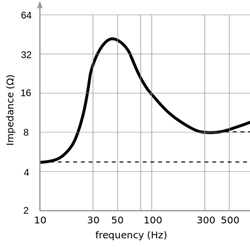
Impedance In Parallel
A good example of parallel loads is a power strip. The full source voltage of 120 volts is delivered to each individual outlet, and plugging more devices in draws more current from the socket. Ohm’s Law says that when current increases at a constant voltage, resistance must decrease, and that’s exactly what happens.
It’s a bit off to think about, but adding a branch to a parallel circuit will always decrease the total impedance. Two 8-ohm monitor wedges placed in parallel load the amp to 4 ohms, three 8-ohm wedges load the amp to 2.7 ohms, and four would load the amp down to 2 ohms. (It can appear that daisy-chaining wedges places them in series, but the twin jacks are actually wired in parallel, so the amp sees a “fork in the road.”)
The impedance decrease in parallel circuits is due to the fact that by adding another circuit branch, you are adding another possible path for current flow. Imagine the crowd leaving a venue after a show. Perhaps there are two large double doors through which many people can pass. This is analogous to a parallel circuit, as the crowd can pass through either door.
Opening a third door, even a small one, would be like adding another branch to the circuit. You’ve increased the speed with which the crowd can leave the venue by providing an additional possible route. In the same way, load in parallel always decrease total Z as seen by the source.
There are a couple of ways to calculate parallel loads, but the easiest is to take the reciprocal of each branch impedance, add them, then take the reciprocal of the answer. For example, three 8-ohm loads in parallel would give you:
1/8 + 1/8 + 1/8 = 3/8
The reciprocal of 3/8 is 8/3, or 2.7 ohms
Parallel wiring allows for the failure of one branch without disrupting the others, just as you can unplug one plug from a power strip without taking out everything on the strip. But we have to be careful here, since as we add loudspeakers, the amp is loaded down closer and closer to 0 ohms. Even at 2 ohms, the life expectancy of an amplifier is significantly decreased. Although this has become less of an issue with modern, high-quality amplifiers, it’s still a potential cause for concern.
The Perils Of Parallel
The large difference between input Z and output Z on modern devices can cause parallel circuits to behave in non-intuitive ways. Let’s suppose that we’re at a gig and we’re short on inputs, so we use a “Y” cable to combine both outputs from a CD player into a single preamp. This places the CD player’s outputs in parallel with each other. Imagine the situation from the point of view of the left output, which sees the preamp (≈ 10 ohms) and the right output (≈ 10 kilohms).
Remember that audio signals are AC, so cables and connectors can’t be considered “one way.” Signal flow is determined by impedance, not the gender of the cable’s connector. Male XLR connectors are outputs by convention only – signals are under no obligation to obey this. This can be a bit of a brain bender, but the left output’s signal is going to seek the path of least resistance – literally. It will drive the preamp, but it will also try hard to drive the right output due to the low Z.
